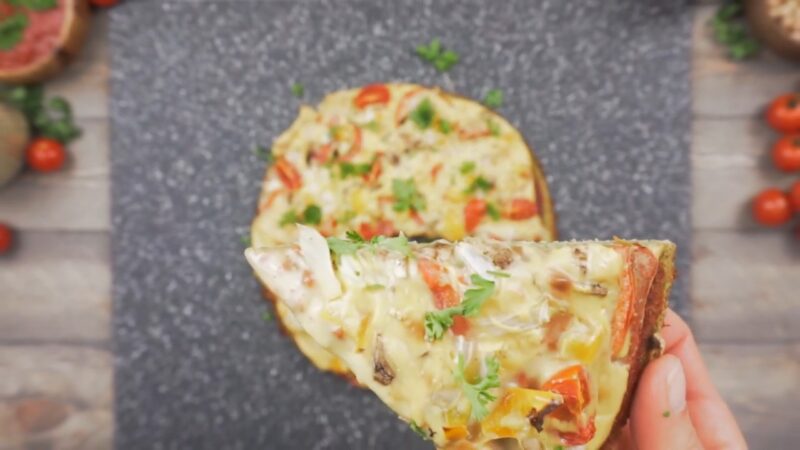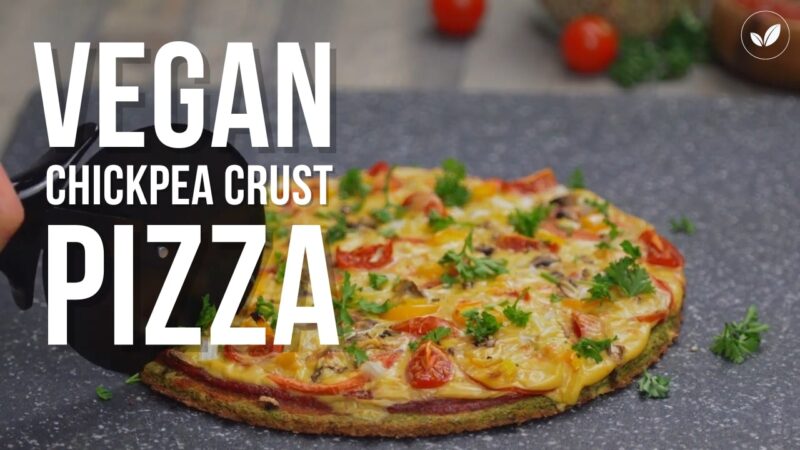Pizza is probably one of the most loved foods on the Earth. However, it’s surely not one of the healthiest foods on the Earth. Until now. Today you’ll learn how to make a healthy and mouth-watering vegan pizza with a gluten-free chickpea crust. This pizza is savory, flavorful, packed with protein and, yes, nourishing and delicious at the same time. Really? Really.
Speaking of pizza, I can never resist. But at the same time, I was very curious to make a much healthier recipe and replace the traditional white flour with something more wholesome. When I got into vegan food, I started to experiment with lots of different ingredients that I’ve never used before.
One of them was chickpeas, and one of my biggest beginner cooking revolutions came when I discovered chickpea flour.
Chickpea flour, also known as gram flour or besan, is made from grounded chickpeas. Pretty simple, huh! This type of flour is frequently used in Indian cuisines. The best part is that chickpea flour is incredibly versatile, meaning you can make so many different dishes using them!
But chickpea flour pizza crust is my so far favorite. And, oh yes, by replacing usual white flour crust with chickpea flour crust, you skyrocket the nutritional value of your pizza.
Chickpea flour is incredibly high in protein – 20g per one cup. This type of flour is also an excellent source of dietary fiber, which is essential for weight loss and optimal digestion. One cup of chickpea flour has about 12.5g of fiber. If you have a gluten sensitivity or you’re just not a big fan of gluten, then, good news – chickpea flour is completely gluten free.
Vegan Pizza With Chickpea Crust

Makes 2 to 4 serves
Ingredients
For the crust:
- 1 cup chickpea flour
- 1/3 cup water (or more if needed)
- 1 tbsp olive oil
- 1 tsp sea salt
- 1/2 tsp turmeric (optional but adds a nice orange color and boost nutritional value)
- a pinch of pepper
For the pizza:
- 200 g tomato paste
- 250 g mushrooms
- 1/2 red or yellow bell pepper
- 1 onion
- 1 tomato
- 1 tbsp of soy sauce
- 1 tsp chopped sun dried tomatoes
- few fresh basil leaves
- a handful of fresh arugula
- olive oil for cooking
Directions:
- Prepare the crust: Preheat the oven to 180C. In a bowl mix chickpea flour, water, 1 tbsp of olive oil, salt, pepper, and turmeric. Stir well until you get a smooth mixture. This won’t be like a regular dough that you can roll on the baking sheet. The chickpea flour mixture will be rather liquid, and you have to spread it on baking paper or silicone baking mat in a round shape 1/2 cm to 1cm (1/4 to 1/2 inch) thick. If you’re using baking paper, sprinkle a bit olive oil on it before you spread on the dough otherwise the dough will stick to the paper. I’ve noticed that silicon baking mat works the best for this dough and you don’t have to use any oil. I used my silicon spatula to spread the dough easily.
- Place the crust into the oven: Bake for about 15 min until the edges are very lightly golden. Look out for over-baking it!
- In the meantime, cook the mushrooms: Heat a frying pan and sprinkle it with some olive oil. Chop the onion and mushrooms. First, cook the onion for about 2 minutes, then add the mushrooms, sun dried tomatoes and soy sauce. Cook for about 7 minutes until most of the water has been removed from the mushrooms.
- Remove the crust from the oven: Spread it with the tomato paste, put on the cooked mushrooms with onions. Chop the bell pepper and tomatoes, spread on the pizza. Put pizza back into the oven, bake for around 10 minutes until tomatoes and bell pepper are soft.
- Remove pizza from the oven and while it’s still hot, spread on the arugula and basil leaves.
Epilogue
And there you have it – a delicious, nutritious, and satisfying vegan pizza with a gluten-free chickpea crust. This pizza is not just a healthier alternative to traditional pizza, but it’s also a culinary adventure, introducing you to new ingredients and flavors.
So, the next time you’re craving pizza, why not give this recipe a try? You might just find that this chickpea crust pizza becomes your new favorite. Enjoy the process of creating it, savor every bite, and most importantly, have fun with it. After all, cooking is not just about feeding the body, but also nourishing the soul. Happy cooking!

